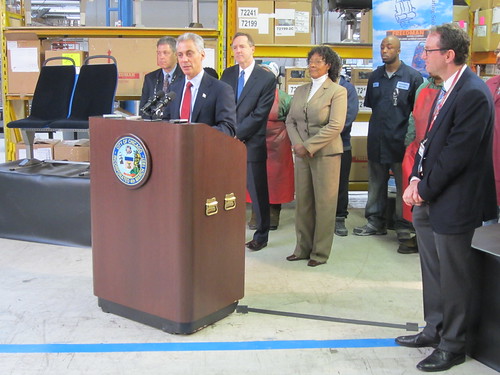This morning at Freedman Seating, a Humboldt Park-based company that will be making seats for hundreds of new CTA buses, Mayor Rahm Emanuel argued that better public transportation can give a shot in the arm to the local economy. The 120-year-old company will be fabricating some 11,100 seats for the transit agency’s $148 million contract to buy at least 300 new vehicles from the Nova Bus company. The CTA says the bus purchase will create up to 100 new local jobs.
During the press conference the mayor noted that 2012 saw the CTA’s highest ridership in 22 years, up 2.4 percent from last year to 545.6 million rides. Train ridership is up 4.2 percent to 231.1 million rides, its highest level in fifty years. The agency claims much of the increase in ridership can be credited to infrastructure improvements.
“Ridership is at a record high here at CTA,” Emanuel said. “That gives the city of Chicago, and the employers and employees that use the CTA, a critical economic advantage, because one of the reasons people want to expand their company or move their company to Chicago is because they can get from home to work or from neighborhood to neighborhood conveniently and efficiently.”
After the mayor’s speech, I asked him about yesterday’s WBEZ report that the CTA and the Chicago Department of Transportation will be pushing for center-running bus rapid transit with travel lane removals on Ashland Avenue from Archer Avenue to Division Street. "No decisions have been made," he said. "But when you look at means of alternative transportation you have to look at [BRT]." He noted that the CTA recently debuted the Jeffery Jump, an express bus service on the South Side incorporating several elements of BRT. "Now there’s an exploration of where else we could do it. Whatever decision we’re going to make, we are going do it after exhaustive discussion with the communities."
"We're looking at whether it makes sense to do [BRT] in the greater downtown area," he added. "Would that be a better way to move commuters to their office after they get off the train? That could be an advantage for all of us as a city, giving us an opportunity to create jobs and economic opportunity. Putting a CTA stop where we’re going to now put one [the upcoming Green Line Cermak station], near McCormick Place, is a big advantage for us as we start to recruit international jobs. Making the type of investments we’re making in bike lanes will help build a new [high-tech] economy. That’s what those kind of employers and those type of workers want. So now we’re looking at bus rapid transit, which also gives you a strategic advantage in creating jobs."
Afterwards I asked CTA president Forrest Claypool if it’s true his agency has already determined the “preferred alternative” for BRT. “The planning process is still very much underway,” he said. “No final assessments have been made. There’s a whole series of potential BRT scenarios that are being reviewed, everything from center lanes or side lanes, to which streets should come first, in the wake of the Jeffery experiment. We are getting closer to completing the community outreach and the analysis and so forth, and we’re working closely with CDOT, but it would be premature to say there are any final recommendations going to the mayor’s office.”
I asked Claypool if it would make sense for the agencies to announce their decision sooner than later in order to head off confusion about the various possible BRT street configurations and fears about the possibility of large-scale parking removal. “Obviously a businessperson has a pretty significant stake in those corridors, if they’re anchored to those corridors," he said. "So balancing the needs of businesses and commuters and trying to drive economic development with BRT so that those businesses win and benefit and grow while also providing a better, faster commute for riders is the goal. It’s a complicated mosaic, and that’s exactly why this process is taking so long and why it’s so complicated. Progress has been made but there still needs to be more outreach and more discussion."
“The city and the mayor have to weigh all the various interests to make sure that BRT is the right thing for Chicago,” Claypool added. “If people will be patient, we’ll get there. I know some people want to jump the gun and come their own conclusions as to where things are headed but let’s let the process play out and then there’ll be a public discussion after a recommendation is made. That will elevate the debate to another level, and out of that hopefully will come something that’s constructive and beneficial for the city.”







